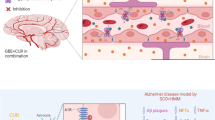Abstract
Aqueous extracts of Reseda luteola L. used as a dyeing agent for centuries have antioxidant activities. The neuroprotective effect of aqueous herb extracts were investigated against glutamate-induced reactive oxygen species (ROS) insult using mouse hippocampal HT22 and cortical neural cells. Aqueous extracts and the hexane fraction of R. luteola L. effectively attenuated the cytotoxicity of glutamate (5 mM) in both HT22 and primary neural cells derived from the mouse cortex. The neuroprotective effect was attributable to unidentified components and luteolin, which is known as a biologically active constituent. Aqueous extracts of R. luteola L. deserve further study for identification of active components and development of food colorants with health benefits.
Similar content being viewed by others
References
Cerrato A, De Santis D, Moresi M. Production of luteolin extracts from Reseda luteola and assessment of their dyeing properties. J. Sci. Food Agr. 82: 1189–1199 (2002)
Lucas CD, Allen KC, Dorward DA, Hoodless LJ, Melrose LA, Marwick JA, Tucker CS, Haslett C, Duffin R, Rossi AG. Flavones induce neutrophil apoptosis by down-regulation of Mcl-1 via a proteasomal-dependent pathway. FASEB J. 27: 1084–1094 (2013)
Kim JS, Kwon CS, Son KH. Inhibition of alpha-glucosidase and amylase by luteolin, a flavonoid. Biosci. Biotech. Bioch. 64: 2458–2461 (2000)
Kim SH, Shin KJ, Kim D, Kim YH, Han MS, Lee TG, Kim E, Ryu SH, Suh PG. Luteolin inhibits the nuclear factor-kappa B transcriptional activity in Rat-1 fibroblasts. Biochem. Pharmacol. 66: 955–963 (2003)
Woelfle U, Simon-Haarhaus B, Merfort I, Schempp CM. Reseda luteola L. Extract displays antiproliferative and pro-apoptotic activities that are related to its major flavonoids. Phytother. Res. 24: 1033–1036 (2010)
Jang S, Dilger RN, Johnson RW. Luteolin inhibits microglia and alters hippocampal-dependent spatial working memory in aged mice. J. Nutr. 140: 1892–1898 (2010)
Casetti F, Jung W, Wolfle U, Reuter J, Neumann K, Gilb B, Wahling A, Wagner S, Merfort I, Schempp CM. Topical application of solubilized Reseda luteola extract reduces ultraviolet B-induced inflammation in vivo. J. Photoch. Photobio. B 96: 260–265 (2009)
Lin MT, Beal MF. Mitochondrial dysfunction and oxidative stress in neurodegenerative diseases. Nature 443: 787–795 (2006)
Villela A, van der Klift EJ, Mattheussens ES, Derksen GC, Zuilhof H, van Beek TA. Fast chromatographic separation for the quantitation of the main flavone dyes in Reseda luteola (weld). J. Chromatogr. A 1218: 8544–8550 (2011)
Peng B, Zi JQ, Yan WD. Measurement and correlation of solubilities of luteolin in organic solvents at different temperatures. J. Chem. Eng. Data 51: 2038–2040 (2006)
Wang H, Joseph JA. Quantifying cellular oxidative stress by dichlorofluorescein assay using microplate reader. Free Radical Bio. Med. 27: 612–616 (1999)
Waak J, Dringen R. Formation and rapid export of the monochlorobimane-glutathione conjugate in cultured rat astrocytes. Neurochem. Res. 31: 1409–1416 (2006)
Seelinger G, Merfort I, Schempp CM. Anti-oxidant, anti-inflammatory and anti-allergic activities of luteolin. Planta Med. 74: 1667–1677 (2008)
Zhang YC, Gan FF, Shelar SB, Ng KY, Chew EH. Antioxidant and Nrf2 inducing activities of luteolin, a flavonoid constituent in Ixeris sonchifolia Hance, provide neuroprotective effects against ischemia-induced cellular injury. Food Chem. Toxicol. 59: 272–280 (2013)
Zhao G, Yao-Yue C, Qin GW, Guo LH. Luteolin from Purple Perilla mitigates ROS insult particularly in primary neurons. Neurobiol. Aging 33: 176–186 (2012)
Li S, Li X, Rozanski GJ. Regulation of glutathione in cardiac myocytes. J. Mol. Cell Cardiol. 35: 1145–1152 (2003)
Author information
Authors and Affiliations
Corresponding author
Rights and permissions
About this article
Cite this article
Kim, S.S., Seo, J.Y., Lim, S.S. et al. Neuroprotective effect of Reseda luteola L. extract in a mouse neuronal cell model. Food Sci Biotechnol 24, 333–339 (2015). https://doi.org/10.1007/s10068-015-0044-9
Received:
Revised:
Accepted:
Published:
Issue Date:
DOI: https://doi.org/10.1007/s10068-015-0044-9




